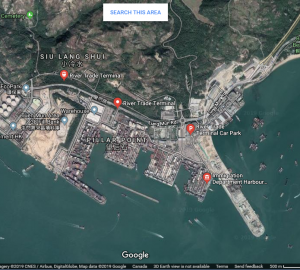
Date: February 20, 2019
Location: Hong Kong, Guangdong Province (China)
Address: 201 Lung Mun Road
Type: Dust Explosion
Fuel: Charcoal Dust
Industry: Shipping (Transportation)
Equipment: Shipping Container
Company: River Trade Terminal
Database Incidents: None Recorded
Loss: No Injuries
Capital Cost: Unknown
Status: Open
Confirmation: Unconfirmed
Company Description:
According to the company website, River Trade Terminal is Hong Kong’s only container terminal for river cargo. It primarily handles and consolidates container and bulk cargo from upstream prior to dispatch to Kwai Tsing Container Terminals.
The terminal was built in 1999 and occupies a 65 hectare-site in Tuen Mun with 49 berths along 3,000 meters of quay front.
Incident Description:
On March 17, 2019, Chinese 24/7 reported a February 20 explosion and fire at the River Trade Terminal in Tuen Mun near Hong Kong, China.
It started when a Liberia-registered cargo vessel from Vietnam carrying 18 containers with 11,000 bags of fine charcoal powder arrived for inspection. Three containers had caught fire (and been extinguished) while the vessel was at sea, but soon after the cargo was offloaded, five containers caught fire.
Firefighters deployed a fire boat and water jet to battle the flames. What made the incident especially harrowing was that there was a risk of explosion if water jets disturbed the combustible fine powder.
As the flames died down, the firefighters realized that the contents of the containers were still smoldering, as water had not fully entered the unit. According to the South China Morning Post, they then used a crane to suspend the five containers and let the charcoal spill out. The area had to be contained, as flash explosions were expected and there were fears that they could get out of control.
One firefighter recalled, “Each time jets from our water cannon hit the suspended containers and their contents, they would disperse fine charcoal powder that was smoldering inside, sparking a dust explosion.”
When the fire was out, fire crews used a thermal inspection camera to confirm that the remaining 13 containers were at a stable temperature before leaving. By then almost 48 hours had passed, but three days later, on February 25, smoke was seen billowing from another three units.
Fire crews extinguished the fire the next day, but decided to take no more chances and checked all other containers. Boring holes into the top of the units, firefighters poured water in and then took out the charcoal bags one at a time. The inspection did not conclude until March 6.
Sources:
Chinese 24/7
South China Morning Post
